Hello dear readers. In this article, we talk about the enormous benefits that yoga can bring to a woman, creating harmony of her soul and body, strengthening the tone of all muscles, developing joints, healing internal organs, filling the body with energy, helping to cure many diseases.
Ancient yoga is unique, but also universally accessible. Millennial yoga techniques are relevant today, they have many directions (, Taoist yoga, etc.).
Everyone can do yoga. Yoga is especially useful for women. A feature of exercises is static. Yoga acts on health gently, contributing to excellent physical shape and a calm psychological state. The benefits of yoga for women are priceless. The reviews of those who practice yoga, as well as the reviews of yoga therapists, say how these techniques are needed for health.
What good yoga is for the fair sex
The list of beneficial effects of exercises (asanas) on the female body is very long. The huge pluses of yoga are that it is suitable not only for young women, but also for the elderly, not only for slim, but also for full. Yes, and you can start practicing it both in youth and in old age. What gives yoga to the female body?
- Regular exercises improve physical fitness, figure, help get rid of excess weight.
- Exercise is the prevention of a wide variety of diseases.
- Muscles, bones, organs get better nutrition. Flexibility is developing. Aging is largely associated with the loss of flexibility of muscles, ligaments, joints. Indian yogis say that a person is young while his spine is flexible.
- In fact, a massage of the internal organs is performed, which gives excellent digestion, normal kidney and liver function.
- The benefit for the body is that asanas perfectly affect the hormonal sphere. For example, the menstrual cycle in yoga practitioners has no failures.
- Special exercises will strengthen the muscles of the pelvic floor, which is very important for the correct fixation of the internal organs of the small pelvis, and as a result, the genitals are healed.
- a separate yoga complex is provided (as for those who have recently given birth).
- The emotional state of women engaged in yoga practices becomes balanced and stress-resistant.
- The skin is rejuvenated, dark circles under the eyes disappear.
- The energy level rises (the woman begins to just feel very good), the protective qualities of the body improve, as does the metabolism.
- Yoga prolongs youth by saying no to early aging. When performing asanas, we breathe differently, our lungs expand much more than usual, gas exchange increases, the work of the heart and blood vessels improves, blood flow increases, pressure returns to normal.
To the question whether yoga is useful, one can absolutely affirmatively answer: yes. And asanas after forty years, when the body begins to slowly age, become a unique opportunity to slow down this process. Only a special rug is needed, knowledge of how to dress for classes, what time of day to engage. As a result, your life will gradually and smoothly change in all its aspects thanks to asanas.
Why yoga asanas are useful for diseases
Yoga for women not only heals the body as a whole, but also perfectly “works” with a huge range of diseases:
1. In diseases of organs located in the peritoneum, many asanas squeeze the abdominal cavity, blood flow in organs increases, metabolic processes, oxygen saturation are activated.
2. In the chest during exercise, blood more actively enters the vessels.
3. For problems with the endocrine glands, the asanas with deflections, inclinations, and also twists work very well on the glands.
4. The respiratory system, heart, blood vessels are rejuvenated, they begin to work much better.
5. Yoga has a wonderful effect on the spine of a woman, joints, ligaments.
6. Asanas help bring blood sugar back to normal.
7. Regular classes will protect you from stress and depression: your psyche is perfectly harmonized.
Are there any contraindications to yogic practices
The first item at the beginning of yoga practice classes should be a visit to the doctor if you have very serious ailments. Otherwise, you can do yourself great harm. For yoga, there are such contraindications:
- Ear surgery on the brain.
- Serious spinal injury.
- Severe damage to the heart, nervous system.
- Pathology of the brain: cerebral and spinal.
- Epilepsy.
- Serious mental disorders.
Simple Yoga Rules
The rules to be followed when practicing yoga are simple:
- Yoga for women is good in a group. It disciplines.
- But you can do it yourself. To find out where to start at home, use the book that the famous yogi Gita Iyengar wrote for women. The book of the father of Gita Iyengar Sri B.K.S. is also an excellent source for learning to perform the exercises correctly. Iyengar, the most amazing yoga of our time. The video in which Iyengar shows yogic asanas will help you a lot.
- You can start with two to three lessons per week.
- Practice should not be earlier than three hours after eating.
- Before going to bed, you do not need to do (3-4 hours before bedtime you can).
- During menstruation, excessive activity is not recommended, it is better to do asanas, which are performed standing or lying down, and exercises in which the legs rise up should be excluded (they will interfere with the timely output of discharge). It is also necessary to limit twists, deflections and asanas in which the press is strained.
- Nutrition should be rational.
- Women are always worried about what to do. The most ideal clothes will be the one that breathes and does not interfere with movements.
What yoga complex is ideal for beginners
Yoga is considered a completely safe occupation. But when performing asanas, you need to protect the spine, muscles, joints, ligaments. Forcing the development of difficult exercises is not recommended to avoid stretching. The first exercises will be beneficial, even if at first you will not perform them completely. Performing a pose, it is important to feel the muscle strain, the joints, but everything is done very smoothly. It is advisable to stay in the asana for 10-15 seconds. The lesson lasts 15-20 minutes at the beginning. Simple practices will prepare the body for further advancement.
The initial yoga complex includes the following exercises:
Standing straight, you stretch your arms up as far as possible, take it a little back, which helps to open the chest. The bent leg needs to be lifted and the foot placed on the thigh (alternately one, then the other). In this position, the spine is very strengthened.

The pose of the child. Put your buttocks on your heels, with your body on your hips, lean forward, clinging to your hips with your stomach. Asana very well relaxes the spinal muscles.
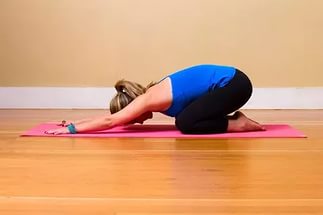
When tilting, you need to place your palms on the floor near the feet, step back, lifting the pelvic part up. Here you need to pay attention to the even distribution of weight between the palms and feet. The head goes down under the elbows. Exercise makes the leg muscles strong, relieves tension in the shoulder girdle and back.

You raise your hands up, bend down, exhaling, down, trying to reach with your hands to the floor with straight legs. Asana develops flexibility of the legs, stretches the back, is a massage for internal organs.
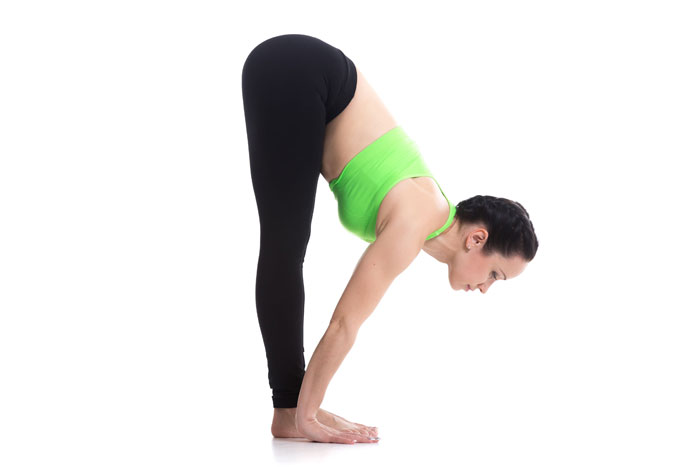
You need to lie on your stomach, hold your ankles, inhaling, raise the upper and lower parts of the body. Exercise strengthens the abdominal muscles.
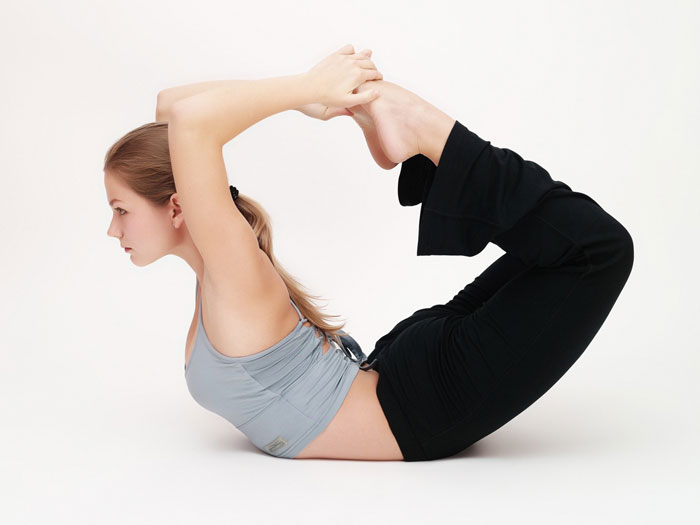
You kneel down, the distance between the knees is approximately equal to the width of the pelvis. Then, exhaling, rest against the lower back (palms or fists) and bend back. Exercise will strengthen your back perfectly.
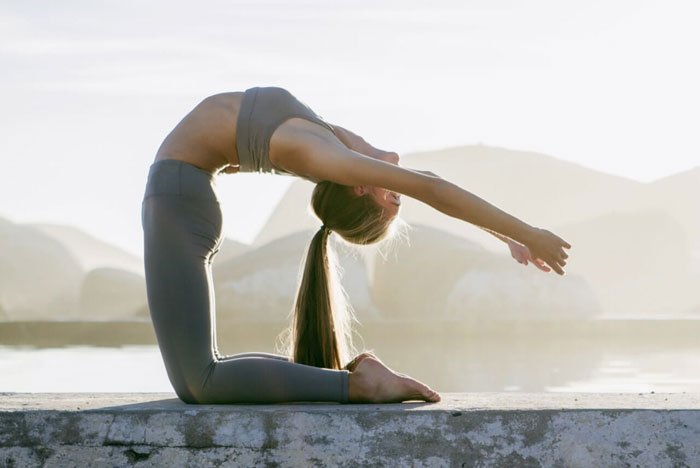
You stand, the distance between the feet is approximately equal to the width of the shoulders. Then stretch your arms up, slowly bend your knees, as if you decided to sit down. The arms and body are in one line. Asana actively affects the spine and legs.
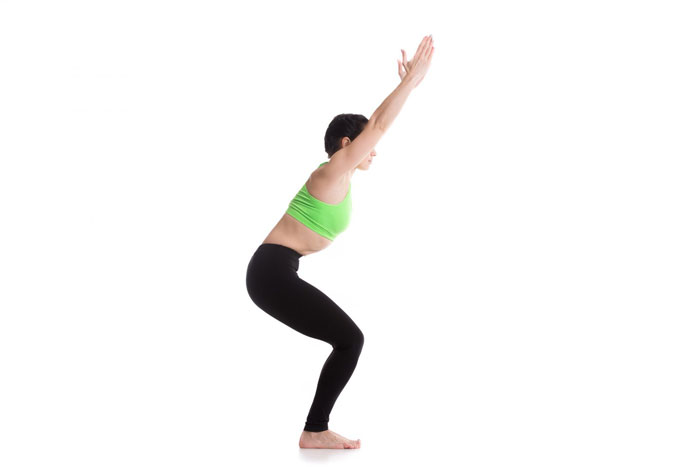
The distance between the legs is about a meter or a little more. One leg needs to be directed outward, the other inward. Hands are spread apart, the body is lowered towards the leg that looks out. You need to get to touch the foot with one hand, stretching the other up. Then the asana is performed again in the opposite direction. The spine is perfectly stretched, the muscles of the back and legs are strengthened.
![]()
You need to lie on your stomach, arms bent (palms on the line of the shoulders). On inhalation, the arms slowly straighten, the upper part of the body comes off the floor (lower abdomen remains on the floor). Asana strengthens the spine.
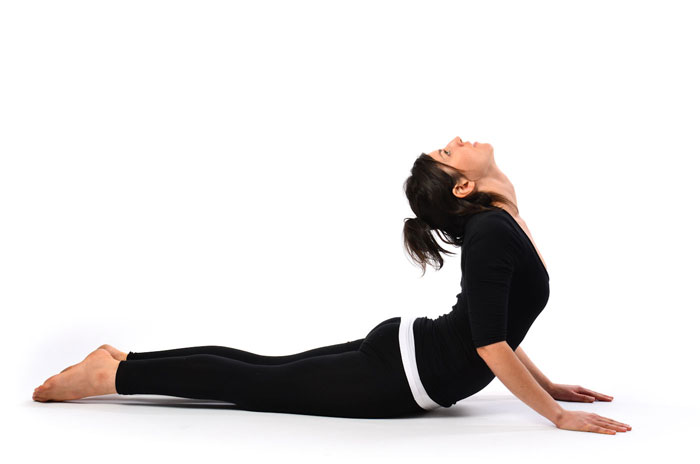
You lie on your back, arms along the torso, raise your legs (not bent), gently lower them back so that they touch the floor. Asana is very good for strengthening the spine.

Candle pose (refers to the main, "royal", yoga poses, we also call it "birch"). You need to raise your legs up, then raise the pelvic part of the body. The palms support the body and are located close to the shoulder blades. The pose perfectly affects the spine, shoulders, internal organs.

Dead pose You are lying on your back, relaxed arms are freely extended along the body, eyes are closed. You need to completely relax, staying in the asana for 2-5 minutes. This posture usually ends any yoga practice.
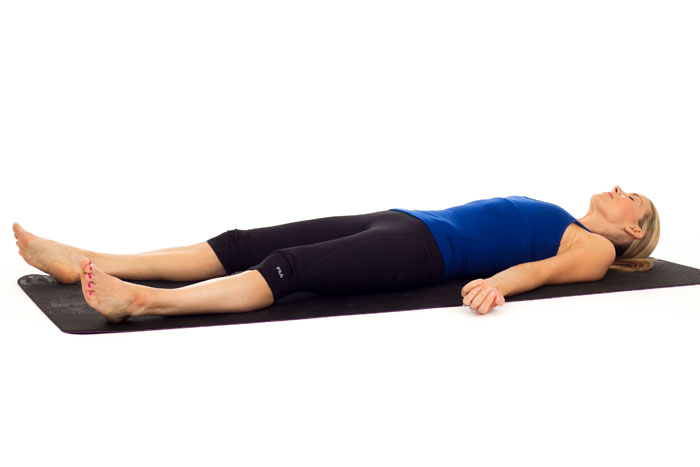
In order for yoga to be exclusively beneficial for youth and beauty of women, the loads must be rational. But regular practice teaches you to hear the body. Yoga can be called a specific way of life, helping to find the perfection of the body and spirit.
If you decide to move on ...
You have mastered the initial set of yoga exercises, regularly practicing yoga, and decided to move on. The book of Gita Iyengar “Yoga is a pearl for women” will help you a lot in this. And this pearl does not lose its unique beneficial qualities for women after 40 years, and after 50, and for 60 year olds.
Gita's father, the great Iyengar, created the yogic system. All his life, the Gita gives women the knowledge of his father.
The book tells why a woman needs yoga, what impact the yoga system has on the entire female body. The asanas, their healing effects, and technique are described in detail. There are sections on women's issues - menopause, pregnancy, childbirth, women's ailments.
What exercises are suitable for women after 55 years
If you are no longer young, but want the body not to age, and there is harmony in the soul, you will really need exercises for women after 55. The main task is well-being, muscle tone, flexibility of the spine, joint mobility, and not the ability to "tie into a knot."
The yoga complex for women after 55 may include almost all asanas for beginners.
If you have mastered the initial complex and want to move on, it is better to do this with an instructor. It is important to remember that it is better not to master, for example, a headstand, in which it is easy to damage the neck. The plow position must be treated with caution, as well as the candle position; in these exercises there is a danger of injury to the elderly spine and muscles: body weight can “fall” on the neck. You also need to carefully listen to the body in those poses where the load goes to the knee joints (for example, in a camel pose).
What to remember:
1. Yoga for women is a unique opportunity to find harmony and improve their health.
2. You can do it both at home and in a group. The regularity of practice is important.
3. Classes prevent many diseases, help slow down the development of a number of ailments.
4. Yoga techniques are available to everyone, you can practice them at any age.
5. Yoga has a positive effect on all systems and organs, on the mind and emotional sphere of a woman.
See you in the next article!
Yoga is the ability to direct the mind exclusively to the object and to keep this direction, without being distracted.
Iyengar Gita. YOGA FOR WOMEN
> > > Iyengar Gita. YOGA FOR WOMEN
Friends, YOGA ENCYCLOPEDIA gives you the opportunity to download materials solely for information. We ask you after review to delete the downloaded works. If you liked the work, we advise you to buy it . You have to pay for everything in life. Do not accumulate karmic debts ;-)
Having mastered the subtle technique of the art of yoga, Gita Iyengar wrote a book where she emphasizes the great importance of yoga in the life of a woman.
3 The book describes a large number of asanas with an explanation of the physical and therapeutic effects, pranayama with its bandhas and dhyana - meditation. Performing these exercises will help practitioners lead a calm, satisfying life.
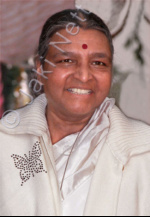 About the author.
About the author.
The daughter of the famous Indian yoga teacher B.K.S. Iyengar.
After 35 years of intensive practice of yoga, she became a faithful assistant to her father in the transfer of his knowledge. She has a diploma in Ayurveda (Vedic medicine), she has deep Sanskrit knowledge and great mastery of spiritual scriptures in the field of Indian philosophy.
Gita Iyengar is the author of the famous bestselling book "Yoga is a Jewel for a Woman" and numerous articles, and also often speaks to the public.
Sri Tirumalai Krishnamacharya (1888 - 1989). "Grandfather of modern yoga", Tirumalai Krishnamacharya - teacher of leading yogis of the 20th century - Pattabhi Jois and B.K. Iyengar. He was born on November 18, 1888, in the town of Muchukunda, Karnataka. Krishnamacharya was an outstanding expert in Sanskrit, Indian religion, philosophy and literature, Ayurveda and other mystical disciplines. In addition to P. Joyce and B.K.S. Iyengar famous students of Krishnamacharya were his son T.K.V. Desikachar (teaches the soft therapeutic style of Viniyoga), and our former compatriot, a resident of Riga Indra Devi, who lived for more than 100 years, taught hatha yoga in Hollywood for 50-60 years, and Zeta in Mexico (she was married to a Mexican diplomat) .
Today in our society, interest in yoga is gradually growing, more and more new books, articles, and video training programs appear. The main drawback of many modern teaching materials is the loss of connection with real, orthodox, traditional yoga. Therefore, if you approach the study of yoga in more depth, you need to find a guru (teacher) or material presented by a real yoga teacher.
Such a teacher today is Gita Iyengar, her name is widely known to everyone who has ever practiced or was interested in yoga. Gita Iyengar - daughter and student of B.K.S. Iyengar, world famous guru. Gita Iyengar gives us all the traditions of yoga that her great father teaches us.
Iyengar Yoga is by far the most popular of all the many varieties of yoga in the world. Iyengar’s book “The Light of Life: Yoga” is today one of the most valuable works on the yoga technique, accessible even to beginners. This book will give anyone an unforgettable journey inside himself, will overcome the path from the human body to the soul.
It should be noted that Iyengar yoga centers are located all over the world, there are thousands of teachers in this area, but only 3 teachers around the world are considered to be carriers of true, orthodox Iyengar yoga, among them (these teachers) and his daughter - Gita Iyengar.
The Gita never leaves India due to centuries-old traditions, so you can learn yoga from it only there, in India. That is why the book of Gita Iyengar "Yoga for Women" is truly an invaluable gift for humanity.

According to the recommendations set forth in this work, everyone can practice yoga, regardless of gender, anyone who seeks to study and learn this ancient teaching. In this book, entire sections are devoted to women's problems - diseases, pregnancy, childbirth, menopause. Men can also master the technique of yoga from this book. Here is a classic technique for performing poses that is equally applicable to both men and women.
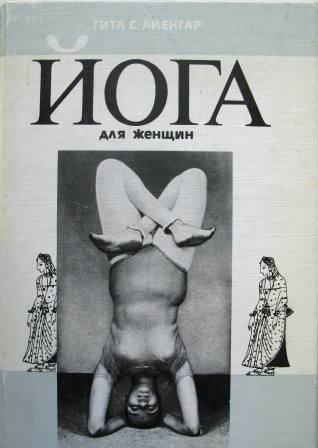
For beginners, this book will be especially useful - it contains in detail all the rules and techniques for performing asanas, designed specifically for beginners. In addition, the book gives detailed descriptions performing asanas by beginners in special cases - during pregnancy, illness, etc.
Gita Iyengar in her book carefully developed all the techniques for using improvised and auxiliary materials when performing asanas, which makes her work as adapted as possible to the conditions of the modern civilized world. In her work, a description of the use of various devices and auxiliary materials allows us to master the most complex poses that a person cannot perform on his own.
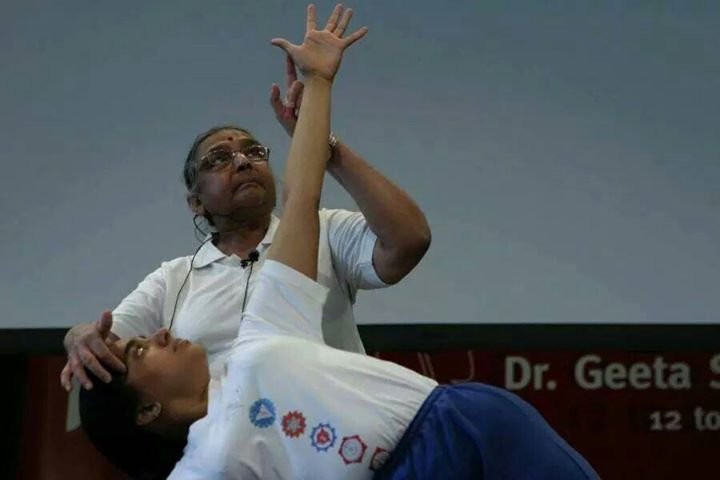
When reading a book, a beginner in yoga may have difficulties in the terminological direction. They are related to the specifics of describing the technique of performing asanas. Look for the answer to your questions in practice, not in verbal explanation. Also, difficulties of this nature often arise due to the fact that Gita Iyengar describes many asanas on mother tongue Yoga - Sanskrit.
Nevertheless, the book by Gita Iyengar is today recognized as the best book that reveals the essence of this ancient teaching. It is recommended both to those who are just getting acquainted with yoga, and to those who have already moved quite far in understanding the philosophy of yoga. It is written in a surprisingly lively language that will be understood by both the teenager and the elderly wise experience.
In addition, it is proposed to familiarize yourself with Iyengar yoga on the following video files:
From early childhood I had a natural tendency towards yoga. From the age of three, I tried to imitate the practice of my father, Sri B.K.S. Iyengar. As a little girl, I got jade (inflammation of the kidneys) and I was hospitalized. Three weeks later, they were discharged with a long list of medications to be taken. For my father, this was a difficult period in his life, and he could not afford to buy expensive medicines. Instead, he recommended that I practice asanas to improve my health. Every time I went to see a doctor, he said that I was better and that I should continue to take medication. Of course, he had no idea that there was nothing to do with the medicine, and that my health improved thanks to yoga.
About a year later, my father took me with him to his guru, Sri T. Krishnamacharya, in Mysore. We waited two days for him to receive us, and when we saw him, he advised me to practice the very asanas that I had already done at that time. I was too young to understand that there is a connection between yoga practices and health, but I myself felt that the condition was improving. Despite the illness, I still did my practice, as I felt that yoga supported me. Practice was for me a kind of elixir of life. I didn’t even like to go somewhere, to communicate with people, because I only wanted to practice yoga and to rise above all life problems. My penchant for yoga was so strong that as a child I said that I wanted to become a sannyasin (a member of the order at the highest stage of the Hindu ashram system). Once, when I was seven years old, my father said that he would demonstrate asanas and wants me to go with him. I was very scared when I was on stage, although I didn’t show it. I just imitated all the poses that my father performed. It seemed incredible to some that I could do them. The body was still weak after the illness, but I was very purposeful.
My father taught me nothing directly; he conveyed to me his intention with a look or an action. When new movements or variations appeared, during practice he looked closely at how much I understood them. He never showed me what I was doing wrong. Instead, he demonstrated a correctly made pose. Yes, I was the daughter of a teacher, but I never had a special relationship in his general classes. He treated me the same way as the others.
Sometimes he put me in the center of the hall so that I demonstrated asanas. He did this because it was easier for him to convey something to the rest of the students. Thanks to these demonstrations, I learned to be more observant and always listen very carefully to what Guruji has said or explained.
I started teaching at the age of 13. I trained my younger sisters, as well as other girls from my school, for yoga asanas between schools. My teacher was a student of Guruji, and she asked me to bring Guruji's photo albums, as she did not know how to perform some difficult poses. This was before the publication of the book “The Light of Yoga”.
Admission to college coincided with the time when Guruji began teaching abroad. While he was outside of Pune, some of his students asked me to help them in their practice, so at the age of 16 I was already a recognized teacher of yoga and still teach.
Over the years, I have seen many people who have managed to improve their health through yoga. I saw relief on their faces when they were able to rise above their pain and relieve suffering under the influence of asanas. In the asana, the mind needs to go inside the body in order to find a calm place there - from there the perfect balance will be felt. If during practice the mind wanders, then the person is not completely present and there cannot be unity. Involvement, interpenetration, and insight are essential qualities for a practitioner.
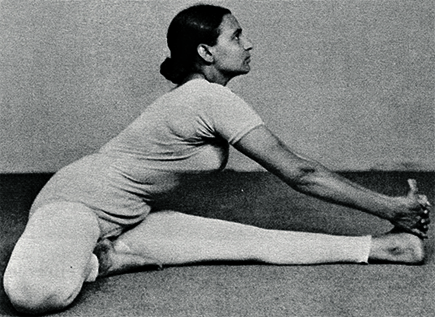
My mother died when I was still very young, and it was an emotionally difficult period for me. For a very long time, none of our family could admit that she was no more. I was the eldest among the children, and the responsibilities that my mother had previously performed fell upon me. I needed to do all the homework, and then still find time for my practice, and also continue to teach yoga in different schools and colleges.
It was difficult for me to maintain balance in my life, but I found that I could do everything I decided. I changed my daily routine - now practitioners came to my house themselves, I stopped visiting them and saved valuable time. Yoga gave me courage and confidence to overcome difficulties.
Guruji is a man who married and had children, but by the state of his mind and by nature he is a perfect yogi. He gave a lot to his family, but at the same time kept a certain distance, creating a balance for himself. He was always very firm on the fine line that separates attachment from detachment. He gave us freedom - we could do whatever we wanted and decide for ourselves what was right and what wasn’t.
Guruji suffered a lot from poverty, it was not easy for him to get every rupee he earned by teaching yoga. Our family finances were often in poor condition. I remember that I was struck by the story about how he rode many miles on a bicycle in order to conduct a lesson - the proceeds were enough for exactly one meal.
When Guruji first arrived in Pune, he felt the contempt of the locals. Many envied his charisma and influence and tried to prevent him from conducting classes, but he had a strong will, and he never gave up.
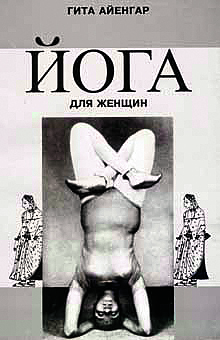 Wherever he went, crowds of people came to see him - he masterfully performed asanas, and he was surrounded by the glory of a yogi who often traveled abroad. He attracted many people - they saw with their own eyes how yoga helped his students. He had many opponents, but Guruji met them all courageously, did not argue with them. He accepted their behavior as part of human nature and said that if he continued to be honest with himself, then he would not care what someone was saying about him. He had great faith in the teachings of his guru and in his own sadhana (practice). I would say that Guruji was the first yogi who drew the attention of ordinary people of India to yoga - he rediscovered it for them.
Wherever he went, crowds of people came to see him - he masterfully performed asanas, and he was surrounded by the glory of a yogi who often traveled abroad. He attracted many people - they saw with their own eyes how yoga helped his students. He had many opponents, but Guruji met them all courageously, did not argue with them. He accepted their behavior as part of human nature and said that if he continued to be honest with himself, then he would not care what someone was saying about him. He had great faith in the teachings of his guru and in his own sadhana (practice). I would say that Guruji was the first yogi who drew the attention of ordinary people of India to yoga - he rediscovered it for them.
I believe that the Patanjali Yoga Sutras are the foundation of all the art and science of yoga. It consists of only 196 sutras, which is unusual for such a vast subject, but in each sutra there is enormous depth. Patanjali beautifully described the eight branches of yoga, when he compared them with the petals of a flower, he said that even if one of these petals is missing, the whole flower will lose some of its beauty. Only when a student gets acquainted with a certain method of his guru and embarks on the path of yoga, only then the true meaning of the "Yoga Sutras" of Patanjali will manifest itself.
Even Hatha Yoga Pradipika states that change must come from within, as each change must be interconnected and each transformation must be completely digested before it can move on. Guruji followed this instruction and guided me along the way.
Krishnamacharya showed this path and Guruji. And Guruji, like a devoted disciple, walked along this path, completely immersed in it. Thus, the true meaning of each sutra, with all its depth, manifested itself in Guruji's understanding. He saw the theoretical meaning of each sutra, but also had his own experience. He discovered a connecting thread between Patanjali and himself.
My own definition of yoga? Yoga is the restriction of mental modifications, which is the result of limitations caused by the control of perception, movement of muscles and nerves, mental vibrations and the transfer of consciousness “I” to a place where no individual “I” exists. According to the theoretical explanations of the sastras, the goal of yoga is samadhi (wholeness, completion), but I think that the true goal lies deeper - where there is a pure being. The purpose of yoga, as I see it, is to ultimately get to the inner refuge of eternal truth. The path to this is connected with a long process of transformation.
Through persistent practice of yoga, a person will develop compassion, patience, sensitivity, satisfaction, strength, faith and detachment - any of these qualities can be considered an achievement on the path to discovering inner being.
Gita Iyengar - daughter and student B.K.S. Iyengara, who gives us the ancient tradition taught by Guruji. The name of Gita Iyengar became known in Russia thanks to the publication of the book “Yoga for Women” (or “Yoga is a Jewel for a Woman”), thanks to which thousands of women were able to discover a balanced and competently constructed practice. Today, the Gita — and she will soon turn 70 — continues to teach in Pune, teaching hundreds of students meditation and pranayama.
Recalls the student of Guruji and Gitaji, Elena Ulmasbayeva:
Gita Iyengar - a female brahmachari, always walks in white and does not wear jewelry. Her gaze is directed inward, the impression is that she is not too involved in what is happening around her. Probably, such should be the nuns who live in the world and dedicated themselves to God. In her eyes is depth and experience. Many consider her severe, probably because she is silent, but sees everything and everyone, many are even afraid of her.
I think that she devoted this life to this program, this ministry, renouncing the joys of female fate. In traditional Indian society, the main goal in a woman’s life is to serve her husband and have children (in that order). At a time when Gita was young, it was difficult to imagine a combination of family life with constant teaching in front of a crowd of students from different countries, not only women but also men. Indian society 30 years ago was quite strictly regulated. We can only guess what was the true reason that the Gita chose for herself this difficult and, in my humble opinion, sometimes mournful way. But we can also admire this sacrifice, which turned out to be a great blessing for millions of Iyengar yoga practitioners, because no one passes this method like it does. I bow before you in a deep bow, Gitaji.


